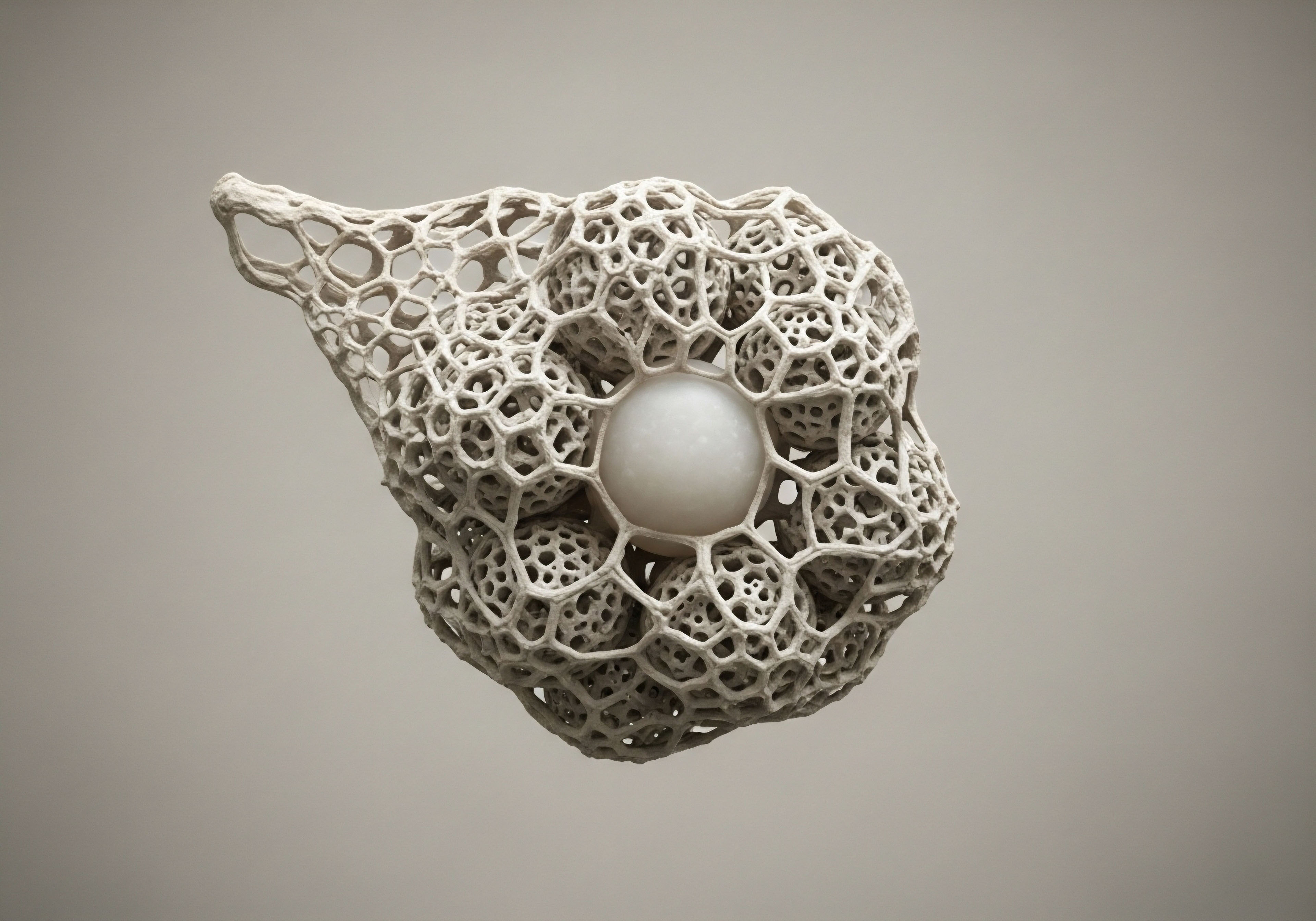

Fundamentals
You have made a commitment. You have changed the way you eat, the way you move, the way you sleep, and the way you manage stress. There is a palpable shift in how you feel, a newfound clarity or a returning sense of vitality. This subjective experience is the most meaningful indicator of progress.
Yet, there is a profound human desire to connect this internal feeling with external, objective proof. You are asking for a map that can confirm the territory you have been exploring, a set of biological signposts that validate your efforts. This is a powerful step in taking ownership of your health, moving from simply following advice to understanding your own unique physiology.
The conversation about hormones begins with the endocrine system, the body’s sophisticated internal messaging service. This network of glands produces chemical messengers, hormones, that travel through the bloodstream to instruct cells and organs on their function. This system governs your metabolism, your response to stress, your reproductive cycles, your energy levels, and your mood.
When you make significant lifestyle changes, you are fundamentally altering the signals you send to this system. Lab tests, in this context, become a way to listen to the body’s response. They provide a snapshot of this complex communication, allowing you to see the downstream effects of your daily choices.
Lab testing provides objective data to complement your subjective experience of well-being, confirming the biological impact of your lifestyle adjustments.

The Three Pillars of Foundational Hormonal Assessment
To begin evaluating the effects of your new protocols, we can concentrate on three core areas that are exquisitely sensitive to diet, exercise, and stress management. These pillars provide a comprehensive starting point for almost any adult seeking to quantify their wellness journey.

The Stress and Resilience Axis
Your body’s management of stress is orchestrated by the hypothalamic-pituitary-adrenal (HPA) axis. The primary hormone in this system is cortisol. When well-regulated, cortisol follows a natural daily rhythm, peaking in the morning to promote wakefulness and gradually declining throughout the day. Chronic stressors, whether from poor sleep, psychological pressure, or improper nutrition, disrupt this rhythm, leading to persistently elevated or dysregulated cortisol levels. This can manifest as fatigue, poor recovery, and difficulty sleeping.
- Cortisol (AM and PM) ∞ Requesting a morning (AM) blood draw for cortisol helps assess your peak level, which is critical for energy and drive. Some practitioners also use a late afternoon or evening (PM) measurement to ensure it is appropriately low before sleep. Salivary testing can offer a more detailed view by taking multiple samples throughout the day, charting the entire diurnal curve.
- DHEA-S (Dehydroepiandrosterone Sulfate) ∞ This is another hormone produced by the adrenal glands. DHEA has a balancing effect on cortisol and is a precursor to other hormones, including testosterone and estrogen. A healthy DHEA-S level relative to cortisol indicates good adrenal resilience. Lifestyle improvements often lead to a more favorable cortisol-to-DHEA ratio.

The Metabolic Machinery
Metabolic health is the bedrock of endocrine function. The way your body processes and utilizes energy directly influences nearly every other hormonal system. The central players here are insulin and glucose. Lifestyle changes, particularly in nutrition and physical activity, have a direct and measurable impact on these markers. Poor metabolic health, characterized by insulin resistance, creates a state of systemic inflammation that disrupts other systems.
- Fasting Insulin ∞ This test measures the amount of insulin in your blood after an overnight fast. High levels indicate that your body is working harder than it should to keep blood sugar stable, a condition known as insulin resistance. Improving your diet and increasing muscle mass through exercise can dramatically lower fasting insulin, a clear sign of enhanced metabolic function.
- Fasting Glucose ∞ Measured alongside insulin, this shows your baseline blood sugar level. While important, fasting insulin is often a more sensitive early indicator of metabolic dysfunction.
- Hemoglobin A1c (HbA1c) ∞ This marker provides a three-month average of your blood sugar levels. It offers a long-term view of glucose control that is less susceptible to daily fluctuations. A downward trend in HbA1c is a definitive sign that your lifestyle changes are improving your metabolic health.

The Energy Regulator
The thyroid gland acts as the body’s central thermostat, regulating metabolic rate and energy expenditure. Its function is deeply connected to stress levels, nutrient availability, and overall inflammation. When you improve your lifestyle, you create an environment where the thyroid can function optimally.
- Thyroid-Stimulating Hormone (TSH) ∞ Produced by the pituitary gland, TSH tells your thyroid to produce its hormones. It is the most common screening test for thyroid function.
- Free T4 (Thyroxine) ∞ This is the primary storage hormone produced by the thyroid. Measuring the “free” or unbound portion indicates how much is available for the body to use.
- Free T3 (Triiodothyronine) ∞ This is the active thyroid hormone, converted from T4 in other tissues. It is directly responsible for metabolic activity at the cellular level. Assessing Free T3 provides insight into how well your body is converting and utilizing thyroid hormone, a process that can be improved with better nutrition and lower stress.
Requesting these foundational tests provides a powerful baseline. They create a clear, data-driven picture of your body’s internal world, allowing you to correlate how you feel with how your systems are actually functioning. This is the first step in a truly personalized approach to wellness.


Intermediate
Moving beyond the foundational markers requires a more targeted investigation into the hormonal systems that govern vitality, reproduction, and physical structure. As you refine your lifestyle protocols, you may want to understand their specific effects on your sex hormones.
This is where we examine the Hypothalamic-Pituitary-Gonadal (HPG) axis, the intricate feedback loop connecting the brain to the ovaries or testes. The tests in this domain provide a detailed blueprint of your male or female hormonal milieu, revealing the progress of your efforts to restore balance and optimal function.
The interpretation of these results depends heavily on context, including your age, sex, and specific symptoms. For women, the timing of the test within the menstrual cycle is also a critical factor. The goal is to move beyond simply seeing if a number is within a broad “normal” range. The objective is to understand your personal hormonal architecture and see how it responds to your inputs.

The Male Hormonal Blueprint
For men, evaluating the impact of lifestyle changes on energy, libido, cognitive function, and body composition involves a specific panel of tests. These markers work together, and understanding their relationships is key to a meaningful interpretation.
- Total Testosterone ∞ This measures the total amount of testosterone in the bloodstream, including both protein-bound and free forms. While a useful starting point, it does not tell the whole story.
- Free Testosterone ∞ This is the unbound, biologically active portion of testosterone that can freely enter cells and exert its effects. This is a much more significant marker of hormonal status than Total Testosterone. Lifestyle improvements, such as reducing body fat and managing stress, can increase the percentage of free testosterone.
- Sex Hormone-Binding Globulin (SHBG) ∞ This protein binds to sex hormones, primarily testosterone and estrogen, rendering them inactive. High levels of SHBG can lead to low free testosterone even if total testosterone is normal. Insulin resistance and poor metabolic health are often associated with lower SHBG, while certain dietary patterns can influence its levels.
- Estradiol (E2) ∞ Estradiol is a critical hormone for men, involved in bone health, cognitive function, and libido. The key is the ratio of testosterone to estradiol. Excess body fat can increase the activity of the aromatase enzyme, which converts testosterone into estradiol, potentially leading to an imbalance.
- Luteinizing Hormone (LH) and Follicle-Stimulating Hormone (FSH) ∞ Produced by the pituitary gland, these hormones signal the testes to produce testosterone and sperm. Measuring LH and FSH helps determine if a low testosterone level originates from the testes (primary hypogonadism) or from the brain’s signaling (secondary hypogonadism). Positive lifestyle changes can improve this signaling pathway.

The Female Hormonal Blueprint
For women, hormonal evaluation is more dynamic due to the cyclical nature of the menstrual cycle. The meaning of a result is entirely dependent on when the sample was taken. Lifestyle changes can have profound effects on cycle regularity, premenstrual symptoms, and fertility.
- Estradiol (E2) ∞ The primary female sex hormone, estradiol levels fluctuate throughout the cycle. A test on day 3 can provide a baseline, while a mid-cycle test can confirm ovulation. Healthy levels are essential for bone density, mood, and cardiovascular health.
- Progesterone ∞ This hormone dominates the second half of the cycle (the luteal phase). It is best measured about 7 days after ovulation to confirm that ovulation occurred and that levels are sufficient to support a potential pregnancy and balance the effects of estrogen. Low progesterone can be associated with PMS, anxiety, and irregular cycles.
- Luteinizing Hormone (LH) and Follicle-Stimulating Hormone (FSH) ∞ As in men, these hormones from the pituitary drive gonadal function. A surge in LH triggers ovulation. The ratio of LH to FSH, particularly when tested early in the cycle, can be an indicator of conditions like Polycystic Ovary Syndrome (PCOS). For perimenopausal women, rising FSH is a key indicator of diminishing ovarian reserve.
- Testosterone (Total and Free) ∞ Women produce testosterone in the ovaries and adrenal glands, and it is vital for libido, muscle mass, energy, and a sense of well-being. As with men, the free fraction is the most important measure.
- DHEA-S ∞ This adrenal hormone is a precursor to testosterone in women. Healthy DHEA-S levels are associated with vitality and resilience.
Evaluating sex hormones requires a nuanced approach that considers the interplay between multiple markers and, for women, the timing within the menstrual cycle.

How Do Different Testing Methods Compare?
The method used to collect and analyze your hormones can influence the results. Understanding the strengths and limitations of each type allows for a more informed testing strategy.
| Testing Method | Primary Application | Strengths | Limitations |
|---|---|---|---|
| Blood (Serum) | Standard for most hormone testing, including thyroid and sex hormones. | Highly accurate and widely accepted. Measures total and free hormones. Covered by most insurance. | Provides a snapshot in time. May not reflect bioavailable hormone levels at the cellular level for some markers. Invasive. |
| Saliva | Often used for cortisol rhythm and measuring free, unbound hormones. | Non-invasive and convenient for multiple daily samples. Good for assessing the diurnal rhythm of cortisol. | Accuracy can be influenced by oral health and collection methods. Less established reference ranges for some hormones. |
| Urine (Dried) | Comprehensive assessment of hormone metabolites. | Provides a view of how the body is breaking down and processing hormones. Non-invasive. Captures an average over time. | Can be influenced by hydration status. More complex interpretation required. Often not covered by insurance. |
By selecting the appropriate panels and testing methods, you can assemble a detailed and dynamic picture of your hormonal health. This data, when paired with your subjective experience, creates a powerful feedback loop, allowing you to intelligently adjust your lifestyle protocols for maximum effectiveness and truly personalized wellness.


Academic
A sophisticated evaluation of hormonal health recognizes that the endocrine system is a deeply interconnected network. Individual hormones do not operate in isolation; they exist within complex feedback loops and are profoundly influenced by other biological systems, including the nervous and immune systems.
To truly measure the effectiveness of lifestyle interventions, we must examine the crosstalk between the body’s primary adaptive systems ∞ the Hypothalamic-Pituitary-Adrenal (HPA) axis, which governs our stress response, and the Hypothalamic-Pituitary-Gonadal (HPG) axis, which controls reproduction and sex hormone production.
Chronic physiological or psychological stress, a common target of lifestyle modification, leads to sustained activation of the HPA axis and elevated cortisol levels. This state of high alert has direct, suppressive effects on the HPG axis. From a physiological perspective, this makes sense; in a perceived state of emergency, the body prioritizes immediate survival over long-term functions like reproduction.
Cortisol can suppress the release of Gonadotropin-Releasing Hormone (GnRH) from the hypothalamus, which in turn reduces the pituitary’s output of LH and FSH. This cascade ultimately leads to lower testosterone production in men and can cause amenorrhea or other menstrual irregularities in women. Therefore, a comprehensive lab assessment must include markers that reflect this intricate interplay.

What Is the Biological Cost of Chronic Stress on My Hormones?
The concept of allostatic load describes the cumulative “wear and tear” on the body from chronic adaptation to stressors. We can measure markers that reflect this load and its impact on the endocrine system. Positive lifestyle changes should, over time, reduce allostatic load, and this reduction will be visible in specific biomarkers beyond the primary hormones themselves.

Advanced Markers of Systemic Interplay
To quantify the deep, systemic impact of your wellness protocols, consider incorporating these advanced markers into your evaluation. They provide a window into the state of inflammation, long-term metabolic control, and adrenal reserve, all of which have profound implications for hormonal function.
| Biomarker | Biological System | Significance in Hormonal Health | Desired Trend with Lifestyle Improvement |
|---|---|---|---|
| High-Sensitivity C-Reactive Protein (hs-CRP) | Immune/Inflammatory | Measures low-grade, chronic inflammation. Inflammation disrupts hormonal signaling, impairs insulin sensitivity, and can increase aromatase activity, altering the testosterone-to-estrogen ratio. | Decrease |
| Homocysteine | Cardiovascular/Methylation | An amino acid that, when elevated, indicates potential issues with methylation and B-vitamin status. Proper methylation is crucial for hormone metabolism and neurotransmitter production. | Decrease |
| Fasting Insulin & Glucose | Metabolic | Beyond basic metabolic health, insulin resistance is a direct driver of HPA axis dysfunction and is a core feature of conditions like PCOS. Elevated insulin can increase SHBG, reducing free hormone levels. | Decrease |
| Hemoglobin A1c (HbA1c) | Metabolic | Reflects long-term glucose control. Advanced glycation end-products (AGEs), formed from excess sugar, cause cellular damage and inflammation, directly impacting endocrine gland function. | Decrease |
| DHEA-Sulfate (DHEA-S) | Adrenal/Endocrine | Represents the output of the adrenal glands. A robust DHEA-S level relative to cortisol suggests healthy adrenal function and resilience, indicating the body is in an anabolic (building) state rather than a catabolic (breaking down) state. | Increase or Stabilize |

The Cellular Impact of Growth Hormone Peptides
For individuals utilizing advanced protocols like growth hormone peptide therapy (e.g. Sermorelin, Ipamorelin/CJC-1295), specific lab tests are essential for monitoring efficacy and safety. These peptides stimulate the pituitary to release Growth Hormone (GH), which in turn signals the liver to produce Insulin-Like Growth Factor 1 (IGF-1).
- Insulin-Like Growth Factor 1 (IGF-1) ∞ This is the primary downstream marker of GH activity. An increase in IGF-1 levels is a direct confirmation that the peptide therapy is effective. The goal is to bring IGF-1 into a youthful, optimal range without exceeding supraphysiological levels.
- Fasting Glucose and Insulin ∞ GH has a counter-regulatory effect on insulin. While beneficial for body composition, elevated GH can potentially increase insulin resistance in some individuals. Monitoring metabolic markers is a crucial safety check to ensure the benefits of the therapy are not offset by negative metabolic consequences.

Synthesizing the Data a Systems Biology Approach
The ultimate goal of this advanced testing is to synthesize the data into a coherent, systems-level understanding of your physiology. You are not just a collection of numbers on a lab report. You are a dynamic, integrated system. An effective lifestyle protocol will not just raise a “good” hormone or lower a “bad” one. It will produce a pattern of positive changes across multiple domains.
Advanced hormonal assessment involves analyzing a network of interconnected biomarkers to measure the reduction of allostatic load and the restoration of systemic balance.
For example, seeing a decrease in hs-CRP, a lowering of fasting insulin, an improvement in the cortisol/DHEA-S ratio, and a concurrent optimization of free testosterone demonstrates a powerful, system-wide adaptation. It shows that your efforts are reducing inflammation, improving metabolic health, enhancing stress resilience, and, as a result, creating an environment where your HPG axis can function without suppression.
This level of analysis moves you from simply tracking hormones to truly managing the complex biological systems that produce them. It is the pinnacle of a data-driven, personalized wellness strategy.

References
- Chiovato, L. Magri, F. & Carlé, A. “Hypothyroidism in Context ∞ Where We’ve Been and Where We’re Going.” Advances in Therapy, vol. 36, no. 9, 2019, pp. 2226-2239.
- Davis, S. R. & Wahlin-Jacobsen, S. “Testosterone in Women ∞ The Clinical Significance.” The Lancet Diabetes & Endocrinology, vol. 3, no. 12, 2015, pp. 980-992.
- Golden, S. H. et al. “Prevalence and Incidence of Endocrine and Metabolic Disorders in the United States ∞ A Comprehensive Review.” The Journal of Clinical Endocrinology & Metabolism, vol. 94, no. 6, 2009, pp. 1853-1878.
- Gröschl, M. “Current Status of Salivary Hormone Analysis.” Clinical Chemistry, vol. 54, no. 11, 2008, pp. 1759-1769.
- Heilmann-Heimbach, S. et al. “Hormonal Regulation in Male Androgenetic Alopecia ∞ Sex Hormones and Beyond ∞ Evidence from Recent Genetic Studies.” Experimental Dermatology, vol. 29, no. 9, 2020, pp. 814-827.
- Mesen, T. B. & Young, S. L. “Progesterone and the Luteal Phase ∞ A Requisite to Reproduction.” Obstetrics and Gynecology Clinics of North America, vol. 42, no. 1, 2015, pp. 135-151.
- Newman, M. et al. “Dried Urine and Salivary Profiling for Complete Assessment of Cortisol and Cortisol Metabolites.” Journal of Clinical & Translational Endocrinology, vol. 22, 2020, 100243.
- Ranabir, S. & Reetu, K. “Stress and Hormones.” Indian Journal of Endocrinology and Metabolism, vol. 15, no. 1, 2011, pp. 18-22.
- Schorr, M. & Miller, K. K. “The Endocrine Manifestations of Anorexia Nervosa ∞ Mechanisms and Management.” Nature Reviews Endocrinology, vol. 13, no. 3, 2017, pp. 174-186.
- Vegunta, S. Kling, J. M. & Kapoor, E. “Androgen Therapy in Women.” Journal of Women’s Health, vol. 29, no. 1, 2020, pp. 57-64.

Reflection

Charting Your Own Biological Path
The data from these laboratory tests provides a fascinating and invaluable layer of information. It is a map, drawn in the ink of biochemistry, that reflects the landscape of your internal world. This map can confirm your location, show you the progress you have made, and highlight new terrain worth exploring.
The numbers give structure and objectivity to the feelings of change you have already sensed within yourself. They are a powerful tool for validation and a guide for future refinements.
The true power, however, resides in the synthesis of this data with your own lived experience. How does a change in your free T3 level correlate with your daily energy? What is the relationship between your morning cortisol and your perceived stress?
This process of connecting the quantitative to the qualitative is where genuine self-knowledge is forged. The information presented here is a guide, but the journey is uniquely yours. The ultimate goal is to become so attuned to your own body that these tests become periodic checkpoints on a path you already know you are on, confirming a state of vitality you have consciously and deliberately built for yourself.



